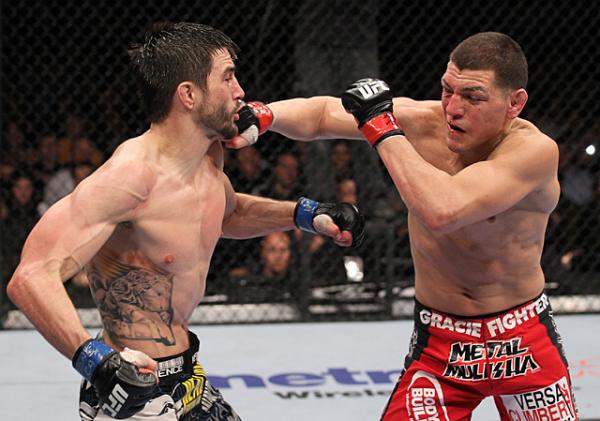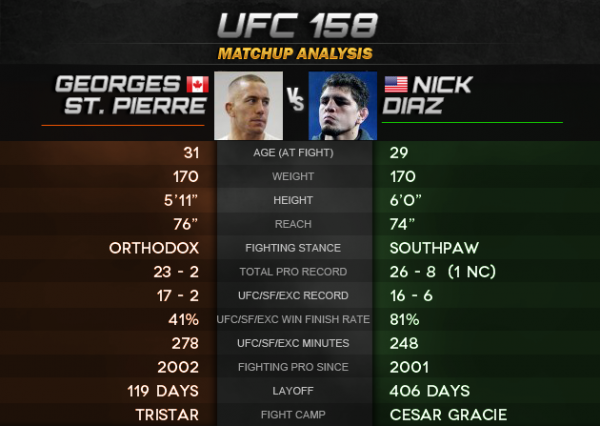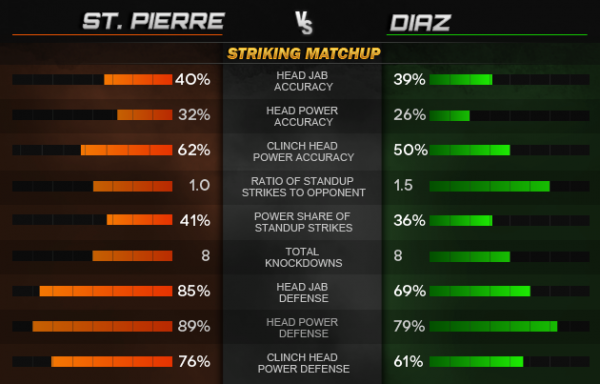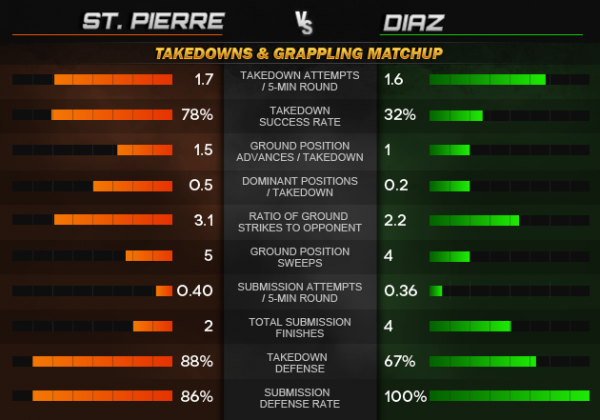
Nick
Diaz has some of MMA’s sharpest hand skills. | Nick Laham/Zuffa
LLC/Getty Images
One of the most memorable media calls of all-time has thrown fuel onto the fire of the long-awaited showdown between reigning Ultimate Fighting Championship welterweight titleholder Georges St. Pierre and former Strikeforce champion Nick Diaz. The contrasting personalities that verbally sparred on the teleconference foreshadow clear stylistic differences between the two highly skilled and physically fit fighters. The incumbent is a tireless technician who excels across the board in skill metrics -- a true mixed martial artist. The challenger is a bold and dangerous striker-grappler, whose brawler mentality belies a sophisticated, multi-pronged attack. The fight for which fans have been calling for years will finally go down at UFC 158 on Saturday at the Bell Centre in Montreal. It is safe to say the local fans in the arena will be biased, but with the help of some diagnostic analysis of the two fighters, we will be armed with the facts.
Between their performances in the UFC, Strikeforce and EliteXC, there were almost 30,000 data points through which to sift. Here is what those numbers tell us:

Starting at the beginning of the Tale of Tape, we see two fighters in the range of their physical peaks, with not much of an age difference. Though St. Pierre has a slightly longer reach, but Diaz counters by being a natural left-hander. Over the years, however, St. Pierre has effectively learned to switch stances, depending on the opponent and strategy. Though slightly younger, Diaz has the longer and more diverse fighting career, including a win in the boxing ring in 2005.
Advertisement
In contrast to his last fight, St. Pierre is now the more current competitor after defeating Carlos Condit less than four months ago. Diaz, on the other hand, is coming off of a loss and a suspension that has kept him out of competition since his own five-round fight with Condit way back in early February 2012, more than one year ago. Conditioning does not appear to be a problem for Diaz, however, as he competes in endurance sports recreationally and has been highly motivated training for this fight. Still, it does raise questions about how long it will take for him to get comfortable again in the cage. In his prior fight with Condit, Diaz struggled with his opponent’s long-range fighting style and was only successful closing the distance late in the bout. Against St. Pierre, he will need to figure out a game plan quickly in order to avoid succumbing to the champion’s notoriously methodical, bell-to-bell style.
Regardless of where this fight goes, there are reasons to be
interested in how they match up. With that said, these two will
begin the fight standing across from each other, so I will start
with the striking statistics.

Unsurprisingly, both fighters have great technical skills, and, offensively, they have similar profiles. They both utilize the jab effectively. Each fighter throws more jabs than power strikes and does so with very high accuracy. They also both have knockdown power, higher than the welterweight average, logging eight knockdowns apiece in the fights analyzed. Punch-for-punch, St. Pierre’s is higher. Their power strikes land with good accuracy, though again St. Pierre has an edge. The widest differentials here are Diaz’s pace and St. Pierre’s defense.
In prior fights, Diaz has controlled the cage, using his dangerous “Stockton Slap” in high volume. He generally outpaces his opponents in standup striking by about 50 percent, though he was unable to do so in his recent fight against Condit. Overall, Diaz’s pace of significant strike attempts is the highest of any fighter on the card. While he is accustomed to dictating the pace of fights, St. Pierre’s technical and controlling style is the perfect foil to Diaz’s volume.
On the flipside, St. Pierre may match his opponents in pace, but between his own high accuracy and his opponents’ poor rate of landing strikes against him, the champion gets the better of standup exchanges in the long run. His head striking defense is actually quite amazing when put in context: St. Pierre continually faces the best welterweights in the world, and, yet, they cannot land strikes at even half the average rate of accuracy for the division. Diaz’s power head striking defense is slightly above average, but his jab defense indicates some willingness to eat a few extra shots. Fortunately for Diaz, the numbers show he is much less likely to be knocked down than the champion per strike landed, which again complicates the balance of power.
In terms of varying the standup attack, St. Pierre will be more likely to work the body and legs, while Diaz focuses primarily on boxing and head strikes. St. Pierre’s standup will be more varied, and, as is always the case with a disciplined fighter, the strikes and combinations will often serve as setups for more dangerous or strategically important attacks. Diaz, in contrast, tends to wade forward, eating some combinations but stalking opponents with a barrage of punches almost exclusively to the head. Only two percent of Diaz’s standup strikes are leg kicks, the lowest of any fighter on the UFC 158 main card. These tradeoffs will certainly make for an interesting first few exchanges. Even so, let us not overlook where this fight might end up going, and that is to the floor.

The defending champion’s wrestling is one of the most effective weapons in the UFC, and he attempts takedowns at a rapid clip. His 78 percent takedown success rate has resulted in 75 takedowns landed, which puts him atop both FightMetric UFC career records lists. While Diaz has historically attempted takedowns almost as often, his success rate is much lower. In fact it is one of the only metrics in which he is below average for the division. GSP also has the edge in takedown defense over Diaz, so the numbers give the edge to the champion if he wants to fight on the ground.
Once on the ground, each fighter has been successful in prior fights. Both vastly out-strike their opponents, attempt submissions at similar rates and have good submission defense. While Diaz’s submission game may be more honed than St. Pierre’s, it is not as if the champion has not fought inside the guard of dangerous Brazilian jiu-jitsu practitioners before. This could end up being the key to the fight: St. Pierre’s ability to put Diaz on his back and do damage without exposing his neck or arm. Diaz taking top control does not look as likely but would certainly make for an unexpected twist to the plot.
The story here is that GSP is more likely to get ground control, and once there, he can effectively work ground-and-pound while avoiding submission attempts. Given that Diaz is a dangerous striker, this may be a sound strategy for the incumbent champion, but it is not without risk. Catching Diaz in a submission seems unlikely, but St. Pierre has the stamina to work on the ground for five full rounds if he needs to. There will be a delicate balance for St. Pierre to maintain position and control while still mounting an offense and minimizing openings for his opponent. If Diaz cannot defend the inevitable takedowns, he will undoubtedly become more and more frustrated and desperate as the fight goes on. His likelihood of securing a submission will also decline with time, as fatigue and sweat begins to affect him, so the first rounds of match will be critical.
The Final Word:
The current betting line favors the champ at -500, implying an 83 percent probability of victory based on that market price. That is a bit higher than St. Pierre’s last line of -350 against Condit, presumably because the questions about his rehab and layoff have now been answered. That fight also saw the biggest threat of defeat that we have seen for the champion since he began his current winning streak back in 2007. The head kick that almost ended GSP’s latest reign added to the one blemish on the St. Pierre stat line: knockdown resiliency.
While he is elusive to the point where most opponents never connect with a clean shot, St. Pierre’s likelihood of being knocked down with a landed power head strike is multiples higher than the same value for Diaz, who has demonstrated a solid chin in recent years. Diaz’s closest recent knockout scare came against the powerful striker Paul Daley, just before Diaz was able to knock out the Brit with strikes of his own. While we see clear advantages for the champion to control the fight on the ground, the greatest threat to him will be Diaz’s boxing.
What do you think? Any particular stats you think reveal the key difference in this matchup? Who wins and how? I will be back next month to run the numbers on “Ultimate Fighter” coaches Jon Jones and Chael Sonnen, as they stop playing nice and fight at UFC 159. Let the lyrical Sonnenisms begin.
Note: Raw data for the analysis was provided by, and in partnership with FightMetric. All analysis was performed by Reed Kuhn. Reed Kuhn, Fightnomics, FightMetric and Sherdog.com assume no responsibility for bets placed on fights, financial or otherwise.
Like Fightnomics on Facebook, or follow on Twitter @Fightnomics to hear when new research and blog posts are available.
Related Articles






